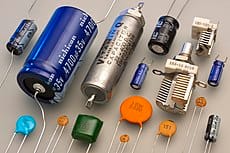Capacitor
A capacitor is an essential electronic component that stores electrical energy in an electric field. It consists of two conductive plates separated by an insulating material known as a dielectric. When a voltage is applied across the plates, an electric field forms in the dielectric, causing positive and negative charges to accumulate on the plates. This accumulation of charges creates a potential difference between the plates, allowing the capacitor to store energy in the form of an electric field.
come in various shapes, sizes, and configurations, each designed to meet specific application requirements. They are widely used in electronic circuits for a variety of purposes, including energy storage, signal coupling, filtering, timing, and voltage regulation. This essay explores the fundamentals their types, construction, working principles, characteristics, and applications across different industries.

Capacitor
Fundamentals:
At its core, a capacitor consists of two conductive plates, typically made of metal, separated by a dielectric material. The dielectric serves as an insulator that prevents direct electrical contact between the plates while allowing the passage of an electric field. The capacitance of a capacitor, denoted by the symbol “C,” is a measure of its ability to store electrical charge per unit voltage.
The capacitance of a capacitor is determined by several factors, including the area of the plates, the distance between the plates (dielectric thickness), and the dielectric constant of the material between the plates. The formula for calculating capacitance is as follows:
C=dε⋅A/d
Where:
- C is the capacitance in farads (F).
- ε is the permittivity of the dielectric material (in farads per meter, F/m).
- A is the area of the plates (in square meters, m²).
- d is the distance between the plates (in meters, m).
Types :
they are classified into various types based on their construction, dielectric material, and intended applications. Some of the common types of capacitors include:
- Ceramic : These use a ceramic material as the dielectric and are known for their small size, high capacitance, and wide frequency range. They are widely used in electronic circuits for decoupling, bypassing, filtering, and coupling applications.
- Electrolytic : Electrolytic capacitors use an electrolyte (typically a liquid or gel) as the dielectric and are polarized, meaning they have a positive and a negative terminal. They offer high capacitance values and are commonly used in power supply circuits, audio equipment, and filtering applications.
Construction:
The construction of a capacitor varies depending on its type and intended application. However, the basic components of a include the following:
- Conductive Plates: it consist of two conductive plates made of metal, such as aluminum, tantalum, or copper. These plates provide the surface area for storing electrical charge.
- Dielectric Material: The conductive plates are separated by a dielectric material, which serves as an insulator. The dielectric material can be made of various substances, including ceramic, paper, plastic, or electrolyte.
- Terminals: it have two terminals, one connected to each conductive plate. The terminals allow to be connected to an external circuit for charging and discharging.
- Enclosure: it are often enclosed in a protective casing or housing made of plastic, metal, or other materials. The enclosure provides mechanical support and protects the internal components from environmental factors.
Working Principles :
The working principles re based on the accumulation of electrical charge on the conductive plates when a voltage is applied across them. When a voltage source is connected to them, electrons flow from the negative terminal of the source to one plate while an equal number of electrons are repelled from the other plate, creating a potential difference between the plates.
As a result, an electric field forms in the dielectric material between the plates, causing positive and negative charges to accumulate on the plates. The accumulation of charges creates an electrostatic potential energy, which allows to store electrical energy in the form of an electric field.
When the voltage source is removed, the stored energy can be discharged back into the circuit. The rate of charge and discharge of a is determined by its capacitance value and the resistance of the circuit.it can store and release energy rapidly, making them useful in various electronic applications.
Characteristics :
it exhibit several characteristics that determine their performance and suitability for different applications. Some of the key characteristics its include:
- Capacitance: Capacitance is the ability of a to store electrical charge per unit voltage. It is measured in farads (F) and determines the amount of energy can store.
- Voltage Rating: Voltage rating is the maximum voltage that can withstand without breaking down. It is important to select a capacitor with a voltage rating higher than the maximum voltage expected in the circuit to prevent damage.
- Temperature Coefficient: The temperature coefficient of a indicates how its capacitance changes with temperature variations. It is expressed in parts per million per degree Celsius (ppm/°C) and affects the stability of performance over temperature.
- Equivalent Series Resistance (ESR): ESR is the internal resistance which affects its efficiency and performance. Low ESR are preferred for high-frequency applications and circuits with low power loss.
- Dielectric Absorption: Dielectric absorption, also known as soakage or charge memory effect, is the phenomenon where a capacitor retains a small amount of charge after being discharged. It can affect the accuracy of timing circuits and voltage regulation.
